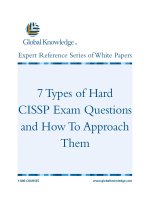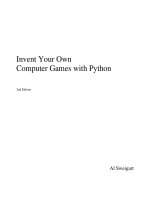- Trang chủ >>
- Khoa Học Tự Nhiên >>
- Vật lý
Physics on your feet berkeley graduate exam questions, 2nd ed
Bạn đang xem bản rút gọn của tài liệu. Xem và tải ngay bản đầy đủ của tài liệu tại đây (22.41 MB, 280 trang )
Physics on Your Feet:
Berkeley Graduate Exam Questions
www.pdfgrip.com
www.pdfgrip.com
Physics on Your Feet:
Berkeley Graduate Exam Questions
or
Ninety Minutes of Shame
but a PhD for the Rest of Your Life!
Second Edition
Dmitry Budker
University of California, Berkeley, USA and Johannes Gutenberg University, Mainz,
Germany
Alexander O. Sushkov
Boston University, Boston, MA, USA
Illustrated by Vasiliki Demas
1
www.pdfgrip.com
3
Great Clarendon Street, Oxford, OX2 6DP,
United Kingdom
Oxford University Press is a department of the University of Oxford.
It furthers the University’s objective of excellence in research, scholarship,
and education by publishing worldwide. Oxford is a registered trade mark of
Oxford University Press in the UK and in certain other countries
c Dmitry Budker, Alexander O. Sushkov, Vasiliki Demas 2015, 2021
The moral rights of the authors have been asserted
First Edition published in 2015
Impression: 1
All rights reserved. No part of this publication may be reproduced, stored in
a retrieval system, or transmitted, in any form or by any means, without the
prior permission in writing of Oxford University Press, or as expressly permitted
by law, by licence or under terms agreed with the appropriate reprographics
rights organization. Enquiries concerning reproduction outside the scope of the
above should be sent to the Rights Department, Oxford University Press, at the
address above
You must not circulate this work in any other form
and you must impose this same condition on any acquirer
Published in the United States of America by Oxford University Press
198 Madison Avenue, New York, NY 10016, United States of America
British Library Cataloguing in Publication Data
Data available
Library of Congress Control Number: 2021934833
ISBN 978–0–19–884236–1 (hbk.)
ISBN 978–0–19–884237–8 (pbk.)
DOI: 10.1093/oso/9780198842361.001.0001
Printed and bound by
CPI Group (UK) Ltd, Croydon, CR0 4YY
Links to third party websites are provided by Oxford in good faith and
for information only. Oxford disclaims any responsibility for the materials
contained in any third party website referenced in this work.
www.pdfgrip.com
To the memory of our teacher and dear friend, Max Zolotorev (1941-2020)
www.pdfgrip.com
Preface to the Second Edition
In the few years that passed from the publication of the First Edition of the book, we
received a lot of positive feedback and encouragement from our readers and colleagues,
which has motivated us to continue keeping an eye out for good questions suitable
for oral PhD exams, now also at the Johannes Gutenberg University at Mainz and
Boston University, the respective schools where the two of us currently teach (and give
examinations). Some colleagues have offered us such questions, and, as before, we have
come up with a number of “exam-style” questions ourselves.
The Second Edition extends the book rather significantly, with new problems found
towards the ends of the sections and new cartoons skillfully drawn by Dr. Vasiliki
Demas added throughout the book. We have also taken the opportunity to correct the
(surprisingly few) misprints and minor errors noticed in the First Edition.
We hope the readers continue to find Physics on Your Feet useful and perhaps
entertaining!
Dmitry Budker
Alex Sushkov
Mainz and Boston
July 2020
www.pdfgrip.com
Preface to the First Edition
How this book came about
In May 2010, the Physics Department of the University of California at Berkeley
where the two of us, at different times, had been Ph.D. students, abandoned the
Preliminary Oral Examinations, a.k.a oral prelims, for the first-year graduate students,
thus breaking a 60-year-long tradition.
In fact, oral examinations were offered at the Berkeley Physics Department much
earlier, however, their most recent format and scope more or less settled by 1950, as
described by A. C. Helmholz in his History of the Physics Department. 1950–1968
(Helmholz, 2004).
The Berkeley prelim was a scary experience for those of us on the “receiving end
(A. S.),” and a half-day semi-annual chore for those administering the test (D. B. did
this from Fall of 1995 through Spring of 2010; he “missed” taking the oral prelims as
he entered the Berkeley Physics graduate program in 1989 as a continuing student, but
has had his share of oral examinations elsewhere). Nevertheless, the two of us strongly
feel that this has been extremely useful for the students, providing them, perhaps, the
first “real-life” scientific-communication experience, and giving an opportunity to look
at the beautiful world of physics in some approximation of completeness.
It has also been a truly rewarding experience for the faculty member (D. B.). One
learned a lot from the brilliant students, and from the wise colleagues asking truly
interesting and profound questions. Some of the material of this book is drawn from the
notes taken by D. B. at the exams over the years, as well as from the questions collected
by the students and passed as an exam-preparation aid “generation to generation.”
The origin of the content of the book, therefore, has collective nature, and we are
extremely grateful to the members of the Berkeley physics faculty who have generously
allowed us to use their ideas. Unfortunately, many of our sources are no longer alive
to ask for permission. We remain in deep gratitude to Profs David Judd, Gil Shapiro,
Ronald Ross, and, indirectly, many others.
So what’s the point of the book now that the Berkeley orals are no more? We
hope this collection will be useful to students (of all ages and everywhere) who wish to
refresh and/or test their knowledge of physics, and also to students at the universities
that still administer orals. And there are always written prelims, qualifying exams,
even at Berkeley (at least, for now) ... The level of the readers we primarily aim at
is upper-division undergraduates and first-year graduate students, although some of
these problems will certainly be enjoyed by postdocs and distinguished physics faculty,
looking for a fun break from or an unexpected contribution to their research.
We have had a lot of fun writing up the problems for this book, and we would like
our readers to share this joy (rather than stress out about the upcoming exam, which
is unproductive). We are greatly assisted in this by the eye-pleasing drawings prepared
by our skillful illustrator, Dr. Vasiliki (Vicky) Demas.
www.pdfgrip.com
viii
Preface to the First Edition
m
v
Other books
There are several other collections of problems with the scope and goals partially
overlapping with ours. Among these are the following.
• Scattering and Structures by (Povh and Rosina, 2005), which is a lovely collection
of problems for the German oral Diploma and Ph.D. exams with emphasis on
quantum phenomena.
• A Guide to Physics Problems by Cahn, Mahan, and Nadgorny (Cahn, Mahan, and
Nadgorny, 1994), which is a wonderful collection of written examination problem,
also supplied with many delightful cartoons (not to mention the most insightful
physics).
• An impressive multi-volume Problems and Solutions set by a group of Chinese
authors (Zhang, Zhou, Zhang, and Lim, 1995; Lim, 1998; Bai, Guo, Lim, 1991;
Lim, 2000) compiled by the Physics Coaching class at the University of Science
and Technology in China as a guide for preparation to Ph.D. exams at major
American universities. While this collection appears to be very useful, we find the
choice of questions and style of solutions to be substantially different from our
own.
www.pdfgrip.com
How to use this book
ix
• University of Chicago Graduate Problems in Physics, with Solutions by (Cronin,
Greenberg, and Telegdi, 1967) is another great collection, although it generally
appears to be more mathematical than this book (and has no cartoons!).
• University of California, Berkeley, Physics Problems, with Solutions by (Chen,
1974) is a forty year-old collection of problems based on the Berkeley written
Ph.D. exams.
How to use this book
We decided to present the solutions right after the problems, instead of separating
them into a different part of the book. Nevertheless, as with all respectable problem
books, it is recommended that the reader begins by suppressing the temptation to read
or peep into the solution right away, and gives the problem an honest “college try”
before consulting with the solution (which may be wrong and/or inelegant, anyway).
Some of the material in the solutions clearly goes beyond of what may be expected at an
oral examination. We provide these discussions for those readers who may be interested in
more in-depth details about the subject and mark the corresponding passages that can be
omitted without sacrificing the quality of exam preparation by placing them in the “aside”
environment as this paragraph.
Have fun and good luck!
Dmitry Budker
Alexander O. Sushkov
Berkeley and Harvard
March 2014
www.pdfgrip.com
Acknowledgements
The original title of this book with which we “lived” for a long time was Ninety Minutes
of Shame (but a PhD in Physics for the rest of your life), however, our OUP Editor,
Sonke Adlung warned us that this title puts book in serious danger of landing in a
wrong section of a bookstore ... We are deeply grateful to Sonke for his patient help
and guidance over the years it took to complete this project.
This book would not have been possible without our mentors, colleagues, and
students whose ideas inspired many of the problems and solutions found in this book.
Their suggestions, guidance, and readings of countless drafts were invaluable, and we
sincerely appreciate their contributions.
In the semester preceding the completion of the book (Fall 2013), D. B. taught an
undergraduate senior elective course at Berkeley called “Physics for Future Physicist”
largely based on the problems in the book. The feedback from the students (several of
whom actually non-physicists) was enormously helpful.
Some people we would like to acknowledge specifically are Derek Jackson Kimball,
Marcis Auzinsh, Byung-Kyu Park, Sean Carroll, Eugene D. Commins, Mikhail Kozlov,
Oleg Sushkov, Victor Acosta, Angom Dilip Kumar Singh, Vladimir G. Zelevinsky,
Dmitri D. Ryutov, Richard A. Muller, Nathan Leefer, Ron Walsworth, Max Zolotorev, Steve Lamoreaux, Gregory Falkovich, Pauli Kehayias, Konstantin Tsigutkin,
Brian Patton, Michael Solarz, Ron Folman, Szymon Pustelny, Ori Ganor, Michael Hohensee, Mikhail Lukin, Ran Fischer, D. Chris Hovde, Yehuda B. Band, Joel Fajans,
Peter Milonni, Sifan Wang, Sean Lourette, Maria Simanovskaia, Simon Rochester, and
Tamara Sushkova. Damon English helped to set this project in motion and provided
invaluable input at its early stages.
In conjunction with the Second Edition, we would like to acknowledge, in addition to the individuals listed previousley, Arne Wickenbrock, Valerii Zapasskii, Masha
Baryakhtar, Lykourgos Bougas, and Diana Saville.
The authors acknowledge the support of their research, that motivated many of
the problems in this book.
www.pdfgrip.com
Contents
1
Mechanics, Heat, and General Physics
1.1 Bouncing brick
1.2 Slippery cone
1.3 Roach race
1.4 Spinning Earth
1.5 Mechanical oscillator as a force sensor
1.6 Hot-dog physics
1.7 Ostrich egg
1.8 Joker’s pendulum
1.9 Slinky magic
1.10 Lightbulb and coal
1.11 Comfortable walking speed
1.12 Rotating dumbbell
1
3
5
7
9
11
15
19
21
23
25
27
29
2
Fluids
2.1 Bubble physics
2.2 Bubble and pressure
2.3 Holey bucket
2.4 Surprises in melting and solidification
2.5 Shallow-water and deep-water gravity waves
2.6 Tides
2.7 Boat speed limit (hull speed)
2.8 Floating in circles
2.9 Boat displacement
2.10 Temperature lapse in the atmosphere
2.11 Angler’s dilemma
32
33
37
39
43
47
51
53
55
57
59
63
3
Gravitation, Astrophysics, and Cosmology
3.1 Olber’s paradox: why is the sky dark?
3.2 Gravitational shift of clock rates
3.3 Photon fallout
3.4 Planck mass and length scale
3.5 Rotation of stars around the center of a galaxy
3.6 Ultralight dark matter
3.7 Detecting gravitational waves
3.8 Dark matter trapped in the Earth
66
67
69
73
75
77
79
83
87
4
Electromagnetism
4.1 Currents and magnetic fields
4.2 Electromagnet design
90
91
95
www.pdfgrip.com
xii
Contents
4.3
4.4
4.5
4.6
4.7
4.8
4.9
4.10
4.11
Field in a shield (with a coil)
Multipole expansion
Energy in a wire
Earth’s magnetic field angle
Refrigerator-magnet science
Spherical-cell magnetometer
Magnetic force on a superconducting magnet
Circuit view of atoms and space
Magnetic monopole
97
101
105
109
111
115
117
121
125
5
Optics
5.1 Rotating liquid mirror
5.2 Stacking lenses
5.3 Nanoparticle optics
5.4 Diffraction angle
5.5 Diffraction on an edge
5.6 Black-body radiation
5.7 Laser vs. thermal light source
5.8 Correlation functions for light and Bose condensates
5.9 Pulsed laser repetition rate
5.10 Beamsplitter
5.11 Rotating linear polarization
128
129
131
137
139
141
143
145
149
153
157
159
6
Quantum, Atomic, and Molecular Physics
6.1 Magnetic decoupling of spins
6.2 Level anticrossing
6.3 Bound states in a potential well
6.4 Hypothetical anomalous hydrogen
6.5 Time-reversal in quantum mechanics
6.6 Superconductivity vs. atomic diamagnetism
6.7 Atomic desorption
6.8 Lamb shift
6.9 Van der Waals interaction
6.10 Vacuum birefringence
6.11 Nonmagnetic molecule
6.12 Quantum mechanics of angular momentum
6.13 Light shifts
6.14 Optical pumping
162
163
167
169
177
181
183
187
189
193
197
199
201
203
205
7
Nuclear and Elementary-Particle Physics
7.1 The number of elements in the periodic table
7.2 Neutron anatomy
7.3 Nonexistence of the dineutron
7.4 Deuterium fusion
7.5 Lifetime of the ground-state para-positronium
7.6 Schwinger fields
7.7 Cherenkov radiation
208
209
211
213
215
217
221
223
www.pdfgrip.com
Contents
7.8
8
Neutron optics
xiii
227
Solid-State Physics
8.1 Transistors
8.2 Magnetic domains
8.3 Damaging diamond
8.4 Nearest-neighbor defect in a crystal
8.5 Fermi velocity in a metal
8.6 Superfluid transition of helium
8.7 Frustrated spins
230
231
235
239
241
243
245
249
Appendix A Maxwell’s Equations and Electromagnetic Field
Boundary Conditions
251
Appendix B Symbols and Useful Constants
B.1 Symbols
B.2 Useful constants
253
254
255
References
257
Index
261
www.pdfgrip.com
www.pdfgrip.com
1
Mechanics, Heat, and General
Physics
Entropy isn’t what it used to be.
1.1
Bouncing brick
3
1.2
Slippery cone
5
1.3
Roach race
7
1.4
Spinning Earth
9
1.5
Mechanical oscillator as a force sensor
11
1.6
Hot-dog physics
15
1.7
Ostrich egg
19
1.8
Joker’s pendulum
21
1.9
Slinky magic
23
1.10 Lightbulb and coal
25
1.11 Comfortable walking speed
27
1.12 Rotating dumbbell
29
Physics on Your Feet: Berkeley Graduate Exam Questions: or Ninety Minutes of Shame but a PhD for the Rest of
Your Life! Dmitry Budker and Alexander O. Sushkov, Oxford University press. © Dmitry Budker, Alexander
O. Sushkov, Vasiliki Demas 2015, 2021. DOI: 10.1093/oso/9780198842361.003.0001
www.pdfgrip.com
2
Mechanics, Heat, and General Physics
www.pdfgrip.com
Bouncing brick
1.1
3
Bouncing brick
A brick falls flat onto a tennis ball resting on the ground (Fig. 1.1) and bounces back
to the height of h = 1 m. What height will the ball bounce to? Make reasonable
assumptions, for example, neglect the size of the ball compared to the bounce height.1
Fig. 1.1 A brick falls onto and bounces off of a tennis ball. As a result, the ball also bounces
vertically.
1 This
problem was suggested by Prof. G. L. Kotkin.
www.pdfgrip.com
4
Mechanics, Heat, and General Physics
Solution
When the brick hits the ball, it compresses (squashes) it, and the restoring force, which
is mostly due to the air pressure in the ball, is what pushes on the brick first making
it to stop, and then turn around and bounce back.
Let us consider the moment in time when the brick is on the way up, and the
ball is back to its non-deformed state. Assuming that the ball is at all times in a
quasi-equilibrium state, at this moment, the ball is no longer pushing on the brick.
At this moment, the brick begins its free-fall vertical motion with initial velocity
v0 that can be found from
mv02
= mgh.
(1.1)
2
Let us now consider the motion of the different parts of the ball. The bottom of
the ball is on the ground, and is not moving. On the other hand, the top of the ball is
moving at the velocity of the brick v0 (Fig. 1.1). It is clear, then, that the center of mass
of the ball is moving with v0 /2. Correspondingly, the ball will bounce to h/4 = 25 cm.
Note that tennis players use a related effect to lift a tennis ball at rest on the
court–the technique involves hitting the ball vertically towards the ground with a
racket, upon which the ball bounces up.
www.pdfgrip.com
Slippery cone
1.2
5
Slippery cone
A climber is trying to climb a slippery mountain with a round conical shape. He has
with him a piece of rope with the ends tied together in a knot to form a loop. He
throws the loop over the top of the cone and pulls on it to pull himself up, as shown
in Fig. 1.2. There is no friction between the rope and the cone surface. If the opening
angle of the cone is small (sharp cone), the loop should catch, but if the opening angle
of the cone is large (flat cone), the loop should slip off over the top of the cone, as the
climber pulls on it.
What is the critical opening angle of the cone so that the rope loop just catches?2
θ
Fig. 1.2 A climber pulling himself up with a rope.
2 This
problem was suggested to us by Evgeny Kashmensky.
www.pdfgrip.com
6
Mechanics, Heat, and General Physics
Solution
Suppose the climber has thrown the rope over the top of the cone, but has not pulled it
tight yet. Let us cut the cone from its vertex to its base along the straight line passing
through the knot in the rope loop. We then unroll the cone into a sector of a circle on
a plane (drawing a picture is very helpful at this point, see Fig. 1.3). The knot appears
as two points on the radii bounding the sector, these points are equidistant from the
vertex, which is the center of the circle. The rope joins these two points, tracing out
some curved line contained within the sector.
Now, as the climber pulls on the rope, he puts tension on it. When the rope is
tight, it traces out the curve of locally minimal length on the surface of the cone, or
a geodesic. On the surface of the “unrolled” sector, this is just a straight line between
the two points corresponding to the location of the knot. If the sector is less than half
of a circle, this straight line is entirely within the sector, and therefore the rope catches
somewhere on the surface of the cone [Fig. 1.3 (a)]. If the sector is more than half the
circle, the straight line is outside the sector, meaning that, as the rope is tightened, it
at some point must cross the center of the circle, thus slipping off the top of the cone
[Fig. 1.3 (b)].
The critical cone angle corresponds to the case when the “unrolled” cone forms a
half-circle [Fig. 1.3 (c)]. To work out what the opening angle of such a cone is, let us
denote the radius of the cone base by r and the length of the cone slant by L. The
“unrolled” sector has radius L and arc length of 2πr. When the sector is a semi-circle,
πL = 2πr, and r = L/2. This means that the critical half-cone angle is θ = 30◦ .
(a)
(b)
(c)
Fig. 1.3 An unrolled cone with the rope on its surface.
www.pdfgrip.com
Roach race
1.3
7
Roach race
Four cockroaches are initially located at the corners of a square with side a as shown
in Fig. 1.4. They start moving at the same time with the same speed (not necessarily
constant), in such a way that each roach is always moving in the instantaneous direction of its counter-clockwise neighbor. Assume that the size of a roach is negligibly
small compared to a.
What is the distance traveled by a roach until it collides with another?3
a
a
Fig. 1.4 Four roaches start their journey at the corners of a square and each roach moves
in the instantaneous direction of its nearest counter-clockwise neighbor.
3 This
problem was suggested to us by Elena Zhivun.
www.pdfgrip.com
8
Mechanics, Heat, and General Physics
Solution
By symmetry, the roaches remain in the corners of a (shrinking and rotating) square
at all times till they collide.
Relative-motion problems are often solved most easily by a convenient choice of
the reference frame. In this case, such a frame has the origin on one of the roaches, and
has an axis pointing in the direction of its neighbor. In this frame, our chosen roach
is stationary, while its neighbors approach it along straight lines, covering a distance
a till the encounter. Since the motion of the neighbors is always instantaneously perpendicular, one can see that, indeed, the distance covered by a roach till the encounter
is a, both in the “convenient” and the stationary frames.
We found that many of our colleagues, somewhat surprisingly, have trouble solving
this problem “on the fly.”
www.pdfgrip.com
Spinning Earth
1.4
9
Spinning Earth
This problem illustrates some typical and rather instructive estimates that working
physicists cover their lunch-time napkins with.
(a) Estimate the number of atoms contained in the Earth.
(b) The angular momentum of an atom or a molecule, if it is nonzero, is on the order
of . Estimate the angular momentum of the Earth’s rotation per atom in the units
of .
www.pdfgrip.com
10
Mechanics, Heat, and General Physics
Solution
(a) The radius of the Earth is R ≈ 6400 km = 6.4 × 108 cm, so the volume of the Earth
is
4
V ≈ πR3 ≈ 1027 cm3 .
(1.2)
3
The average density of the Earth is roughly ρ = 5.5 g/cm3 , and the most abundant
(and typical) element in the Earth is oxygen with an atomic weight of 16. From this,
we can roughly estimate the number of atoms in the Earth as
N≈
Vρ
NA ≈ 2 × 1050 ,
16
(1.3)
where NA ≈ 6 × 1023 particles per mole is the Avogadro number .
(b) The angular momentum is given by
L = IΩ ≈
2
2π
M R2 ,
5
τ
(1.4)
where I = 2M R2 /5 is the moment of inertia of a sphere rotating about its diameter,
we have approximated the Earth as a uniform sphere, and τ ≈ 24 hours is the period of
the Earth’s rotation. We can now just substitute the mass of the Earth as essentially
calculated previously, however, it is better to first divide by the expression of the
number of the atoms in the Earth because the mass cancels in the ratio. We have for
the angular momentum per atom (in units of ):
L
=
N
2
2 2π
5MR τ
M
16 NA
≈ 3 × 1017 .
(1.5)
We find that the intrinsic angular momentum of atoms gives negligible contribution to
the angular momentum of the Earth, even if all atoms with nonzero internal angular
momentum were polarized in the same direction.
www.pdfgrip.com









